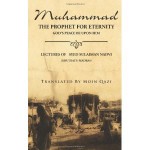Muhammad: The Prophet for Eternity
Lectures of Syed Sulaiman Nadvi (Khutbat e Madras)
Translated by Moin Qazi
Notion Press
Muthu Kalathy Street, Triplicane
Chennai-600005
Rs. 250, Pages 207
Reviewed by Maqbool Ahmed Siraj
Muslims of Chennai, which used to be Madras earlier, used to organize lectures by leading Muslim scholars during the 1920s. Leading intellectuals such as poet Sir Muhammad Iqbal, Syed Sulaiman Nadwi, Abul Ala Maudoodi and Marmaduke Pickthall etc were invited by the Muslim Education Society to speak on various themes. Syed Sulaiman Nadwi spoke on the life and mission of Prophet Muhammad in a series of eight lectures at Laly Hall, Madras in 1925. The first edition of what came to be titled as Khutbat e Madras was published in 1926 and the revised third edition came out in 1936. The lectures need no introduction as invariably all Islamic libraries and Islamophiles preserve a copy of the same edited by the renowned scholar who is better known for his monumental Urdu work i.e., multivolume Seeratun Nabi Sallalahu alaihi wassalam.
Nagpur based journalist and author Dr. Moin Qazi has translated the book into English earlier this year under the above title. Qazi has done a marvelous job and has very ably transferred the essence of the Khutbat into a handy volume running into 200 and odd pages. Lucid language and fluent style impeccably portray the persona of the holy Prophet and explains his mission. While the credit for the contents would go to the original author in Urdu, i.e., Syed Sulaiman Nadwi, the readers in English may find a delightful, nay delectable treat. The language is flawless and idiomatic and allows the reader to sail through the text effortlessly.
Syed Sulaiman Nadwi belongs to a genre of writers who strode the world of Urdu writing like a colossus through the early half of the past century. That era of writing came to an end by the 1950s. While the Partition of the Indian subcontinent took away better part of Urdu-using Muslims to Pakistan, the residual body of Muslims in India had to undergo a linguistic makeover. Writers like Nadwi, Shibli Nomani etc were more heard than read by the generation that followed them. Others of yore whose writings were translated into English, were not fortunate enough to have competent translators like Moin Qazi.
Nadwi had designed the lectures at Madras to highlight the universal appeal and comprehensive nature of the message and persona of the Prophet, peace be upon him. He greatly succeeded in bringing to light several obscure aspects of the Prophet’s life. He sets out with projection of prophets as ideals and the need to revisit, reinterpret their lives and teachings. While most prophets were pre-historic, Muhammad (SAW) came during the full light of history, thereby leaving a legacy quite accessible for those who are literate. Moreover, Nadwi argues that the Prophet represented the fusion of all traits of the preceding prophets and transmuting the message of the Book he carried”the Quran”into a persona.
The first chapter ends on a note worth contemplating. Nadwi happened to travel back to India from Hejaz and Egypt on a ship that was also carrying Nobel laureate, Sir Rabindranath Tagore. Someone asked Tagore as to why Brahmo Samaj did not succeed in its mission although its creed was exceedingly noble and fair. Tagore replied: It could not succeed because it had no personality behind it to provide a practical incarnation of its precepts. The analogy sums up the need for a messenger behind the message.
Writers like Sulaiman Nadwi were held in awe and reverence. It still happens in circles where scholarship is predominantly hinged upon Urdu. But over the last 75 years, considerable literature on Islam has been produced in English and in the West where life of religious figures as well as content of the hagiographic works have been subjected to critical scrutiny. Looked from this angle, Nadwi sounds less than credible when he raises the authenticity of sources other than Quran to a level of the Holy Scripture itself. Last three decades have witnessed serious questioning of countless entries in even Shahih Bukhari and Sahih Muslim, the two most prominent compilations of Hadith. The very fact that most of these works put the age of Hazrath Ayesha (may Allah be pleased with her), at nine, has come under a cloud. New researches put this at 19. Even Ibne Ishaq’s (died 767 AH) biography, considered to be the earliest life sketch of the Prophet (written nearly 125 years after the Prophet’s demise) has been found seriously flawed on several counts.
Yet, Nadwi’s Khutbat did put the Holy Prophet’s message into a homogenous whole for the audiences that were not attuned to reading much in the early half of the last century. He has captured the transformation of a primitive, tribal and pastoral society at the hands of a defenceless and solitary reformer in the persona of the Prophet during the span of 22 years.
The book is a delightful read and packs a world of information between the covers. The translator and the author need to be applauded for the effort and zeal with which they have etched to relief the distinctive objective of the Prophet’s mission.


COMMENTS